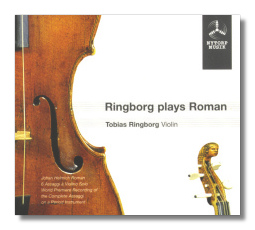
The Internet's Premier Classical Music Source
Related Links
-
Find CDs & Downloads
Amazon - UK - Germany - Canada - France - Japan
ArkivMusic - CD Universe
Find DVDs & Blu-ray
Amazon - UK - Germany - Canada - France - Japan
ArkivMusic-Video Universe
Find Scores & Sheet Music
Sheet Music Plus -
Search Amazon
Recommended Links
Site News
Johan Helmich Roman
Assaggi
Johan Helmich Roman was the central figure in the musical life of the Swedish era of peace following this country's decline as a great power, and is regarded as one of the foremost composers Sweden has ever had. During his years of study in England 1716-21 and in the course of a journey to England, France, Italy and Germany 1735-37 he absorbed detailed knowledge of the musical trends of the period. As conductor of the court orchestra he did important work from the 1720's to the 1740's. Amongst other things he introduced George Frideric Handel's music in Sweden and took active part in the development of public concert life in Stockholm in the 1730's.
His rich and varied output includes occasional music for celebrations at court, sacred choral works, sacred and secular songs as well as works for a wide variety of instrumental ensembles.
Roman's style incorporates impressions from many quarters, chiefly from Handel and contemporary Italians such as Antonio Lotti, Leonardo Leo, Ariosti, G.B. Bononcini and Francesco Geminiani, probably also Pietro Locatelli and Giuseppe Tartini. At a remarkably early stage one finds in him the stylistic manner of the late baroque with an admixture of "style galant", something which is particularly noticeable in the instrumental works. These comprise orchestral suites with several movements, sinfonias of three and four movements, trio sonatas, solo sonatas with basso continuo, compositions for solo violin and keyboard music. In the vocal field his chief contributions were the promotion of a Swedish monody in the form of song with continuo and his conscious endeavour to show "the flexibility of the Swedish language for church music".
Roman's compositions for solo violin for an interesting group of works in his instrumental production. He was himself an accomplished violinist, especially in his younger years, before increasing deafness precluded the possibility of further activity as performer. He was also pedagogically active. In his "assaggi" (essays, experiments, studies) with several movements and small pieces of the nature of etudes for solo violin he left a contribution to the 18th century repertoire for unaccompanied violin that is perhaps without parallel as regards quantity. Many of these are musically rich compositions, and they must still be acknowledged to have great didactic value, not least for the study of the violin playing and the technique of the late baroque. From stylistic point of view thwy have little in common with Johann Sebastian Bach's compositions for solo violin, with which Roman was not aquainted. Rather it appears that Geminiani was one of his chief models; there are too certain resemblances with Locatelli's violin style and Telemann's "fantasias" for the instrument.
That Roman himself valued his Assaggi appears from the fact that he planned to have them printed. This would have been the only contemporary printed edition of his compositions aside from the twelve "Sonate a flavto traverso, violone e cembalo", published in Stockholm in 1727. However, the printing of the works for solo violin were soon halted, most probably for economic reasons. A unique specimen from the first printing with two movements in G minor on two pages are preserved in the library of the Royal Academy of Music. This printing is included the following remarks:
"… this is a sonata from the exercises for the violin by the late Court Intendant and conductor Doctor Roman, published in print by himself, but subsequently withdrawn, so that copies are rather rare", and the dating "Stockholm the 26th June 1740".
The data are confirmed by an advertisement in "Stockholms Post Tidningar", May 12th 1740, where we read of "a beautiful musical piece or so-called assaggio a violino solo", and the reader is further advised that it is "intended to continue with such wirk in the keys most in vogue". There is also other evidence in support of the assumption that at least most of Roman's assaggi were in existence about 1740 and were composed mainly during the 1730's.
The other compositions "in the keys most in vogue" mentioned in the advertisement are preserved only in manuscript. The most important of these sources is a comprehensive and beautifully written but incompletely preserved collection by Roman's colleague and successor Per Brandt (1714-67). This includes a good twenty compositions, the majority complete, but some are fragmentary.
In a way typical for the period the notation of Roman's assaggi presupposes that the performer is familiar with the contemporary practice and style of playing, e.g. in the form of chords which are intended to be broken up into arpeggios. Sometimes a fermata marks the place for an improvised "cadenza", and in numerous instances it is assumed that the soloist will perform certain embellishments, rhythmic variations etc. that are apparent from the notation only in part or not at all.
Both in his autograph and in the printed edition Roman gives several examples of the execution of passages that Brandt has abbreviated in his notation; a number of these instructions as well as other differences of detail between the sources afford a good point of departure for determining the execution of other similar passages.
The above text was loosely written from the extensive introduction to the Assaggio for solo violin, printed by Edition Reimers around 1975. This is an excellent edition full of examples of baroque style violin playing – and it of course contains the six Assaggi by Roman. They are arranged in a way that seems plausible, but one is not completely certain if the assaggi were intended to have four movements each, etc.















